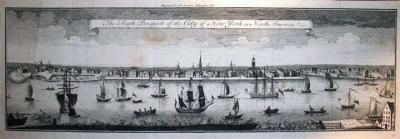Four large colonial prospects, or prospectus views, were engraved at various times during the pre-revolutionary era in the United States. The view of New York was first, then Boston, Charleston, and finally Philadelphia. Each includes a bustling river view with the major architectural landmarks depicted in considerable detail. Although they look similar, they have different artists, printers, and publishers, and do not constitute a set.
South Prospect of New York was designed by William Burgis, engraved in London by John Harris, and issued in 1717. The final print measured over six feet in length, printed from four separate copper plates. The harbor is seen from Brooklyn Heights and might better be called a southeast prospect. The occassion depicted is thought to be a celebration of King George’s birthday.
Burgis’s print was reissued in 1746 by London printseller Thomas Bakewell, with an updating of the skyline. In 1761, the Bakewell reissue was once again revised and re-engraved in a reduced format for the Auguat 1761 issue of London Magazine. This is the print we hold at Princeton, seen above.
In October of that same year, London Magazine printed a prospect of Philadelphia. The original was designed by George Heap in 1754 in the style of William Burgis, but Heap fell ill and died before it was completed. The surveyor for the project, Nicholas Scull, had the engraving finished in London by Gerard Vandergucht. This view measured over seven feet, out-doing Burgis by a foot. A smaller version was completed by Vandergucht in 1755, which included a small section of the Jersey shore in the foreground.
A number of variations of the Scull and Heap view exist, usually based on the second second state. Princeton’s copy, published by London Magazine, was a gift of Alfred E. Kay, class of 1912.

